I wrote this article with a great deal of assistance about 15 years ago.
- Dr. Cate and Dr. McIntosh gave me help on confirming translation points.
- Kham Phoune Sihamayavong gave me the equipment maker’s point of view and technique explanation.
- Carol Cassidy made the introduction and made the information gathering possible.
As always when dealing with weaving equipment and explanations keep in mind translation, maker point of view and cultural nuances always blur the explanation. This is presented from the weaver’s point of view to help increase understanding of how equipment can store complexity in the most simple ways. I am grateful to all my teachers in building my understanding. I hope it spurs some creativity in your world.
The Lao Khao Tam Huuk – One of the foundations of Lao Pattern Weaving
By Deb McClintock and Kham Phoune Sihamayavong June 2002 Linguistic assistance by Dr. Sandra Cate and Dr. Linda McIntosh

The Lao weaver cannot begin to create the beautiful traditional or exciting contemporary textiles without a piece of basic equipment, the khao tam huuk. This pattern storage device allows the weaver to store intricate pickup patterns for repetitive use.
Storing the pattern allows the weaver to focus on the use of color within the pickup design once the initial design is stored.
Definitions
The term khao tam huuk is made up of 4 separate components in the total set.
The feum, two khao noi and the khao yai.

Figure 1
** Khao is the same word as the Lao pronouns he, she, or the idea of a group. Hence, the term Khao Tam Huuk represents the “group” of equipment, the feum, khao noi and the khao nyai.
Feum or beater – used to keep the threads at a set density and to beat the fell line of the cloth into place. Different size feum are used depending on the size of the warp threads.
Khao Noi or shaft – used in a set of two, the warp is threaded in alternating khao noi. Each khao noi is made up of a collection of clasped heddles that hold the individual warp threads. For the non-weaver a single warp thread is controlled by a single clasped heddle. The counterbalance motion of the khao noi against each other raise alternate threads and allow a tie down thread or tabby structure to be inserted between the supplementary pattern wefts of the cloth. In Lao the word for the term clasped heddle is dill or diu. For instructive purposes the term, clasped heddle, will be used going for the remainder of this article.
Khao Nyai – Made up of a collection of dills or clasped heddles, each clasped heddle holds two warp threads as a pattern unit. Use of this khao nyai allows the weaver to store a pickup pattern and move the pickup to a weaving sword to allow for the insertion of supplementary weft between tie down tabby threads.
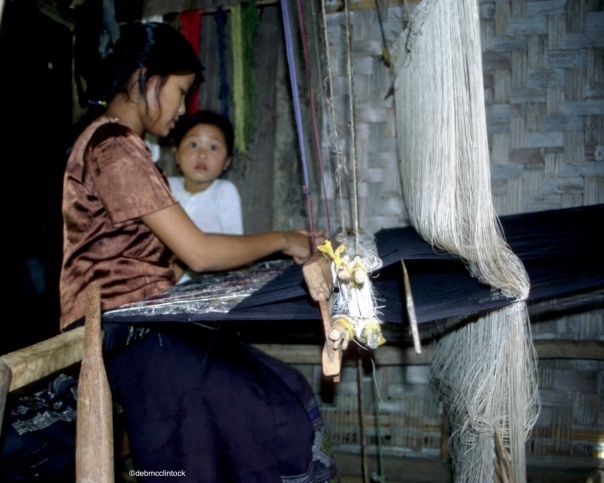
↑The photo above shows the weaving sword in place between the khao noi (shafts) and the khao nyai (pattern storage).
On occasion the term feum is also used to describe the entire set of equipment. One must determine whether one is speaking of the single piece of equipment or the entire set. Sometimes the same term is used interchangeably, depending on the subject being discussed by the weaver. For the purpose of this article the term feum will be used to describe the individual beater.
I observed and photographed Kham Phoune Sihamayavong and his wife, Latee and other family members construct the khao tam huuk parts needed to weave the complex Lao supplementary pattern weft textile. Taught by a friend’s father, Kham Phoune Sihamayavong and his family have made the feums for 20 years. They do this work as part time work, a common Lao way to supplement full time income.

Each unit is made to order based on the weaver’s specifications as defined below.
Discussion of loupe computation
The Lao feum is ordered based on the loupe. A loupe contains 40 teeth and is always 3.3 centimeters long. The final loupe ordered depends on the relationship between the desired total centimeter fabric width and the density of the thread count. For example, if the silk in use requires 600 teeth for 50 centimeters, you divide 600 by 40 in order to get the loupe, hence a weaver would order a 15/50 loupe to get the appropriate size feum for their work.
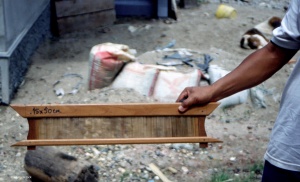 Typically the weaver threads the loom with two warp threads per tooth. The size of the fiber determines how close the bamboo teeth need to be set. The feum would be tailored to fit the density of fiber used. So this fabric will contain a thread count of 1200 ends of silk per the 50-centimeter width of fabric (approx 60 epi). Each weaver has his or her own raw material warp size and product width so the khao tam huuk must be custom made to accommodate the need.
Typically the weaver threads the loom with two warp threads per tooth. The size of the fiber determines how close the bamboo teeth need to be set. The feum would be tailored to fit the density of fiber used. So this fabric will contain a thread count of 1200 ends of silk per the 50-centimeter width of fabric (approx 60 epi). Each weaver has his or her own raw material warp size and product width so the khao tam huuk must be custom made to accommodate the need.
The Feum (Beater) Is Made
Kham Phoune starts with a bamboo culm that is roughly 20 centimeters in circumference. Using a machete he smooths the outside and then splits the bamboo culm vertically into strips. These strips are the basis for the teeth for the feum.
He places the strips into water to keep them moist and prepares the khiang (cutting board) for trimming the strips into teeth. On top of the khiang he makes a jig with nails and a putty knife. Taking each strip he pulls it through the jig and the putty knife trims the edge of the strip. He makes two passes through the jig and flips from one end to the other end of the strip that smoothes and trims each side.
Kham Phoune then adjusts the knife blade closer to the nail and then the strips are flipped and the front and back edges of the strip are run through the jig and smoothed. Four passes are made in which the bamboo strip is flipped so that both sides and ends are shaved smooth. The bamboo strip tooth must be trimmed to the correct size in order to meet the loupe ordered by the customer. Bamboo teeth can always be trimmed down, so he pulls the teeth through the second trim with caution. The teeth are kept in groups to facilitate counting.
He also prepares nylon string for the tying of the teeth by coating it with a layer of black pitch. This black substance, khii suut, comes from the ground. This coating helps hold the knot in place. Once the twine is coated, it is ready to tie the teeth into place.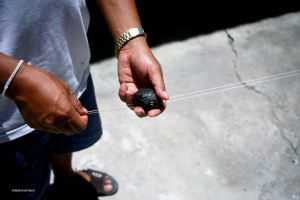 Next he sets up the hawng feum, the jig for tying the teeth to the base sticks of the feum. Hawng represents a room, place or structure; hence the hawng feum is the place the feum is tied.
Next he sets up the hawng feum, the jig for tying the teeth to the base sticks of the feum. Hawng represents a room, place or structure; hence the hawng feum is the place the feum is tied.
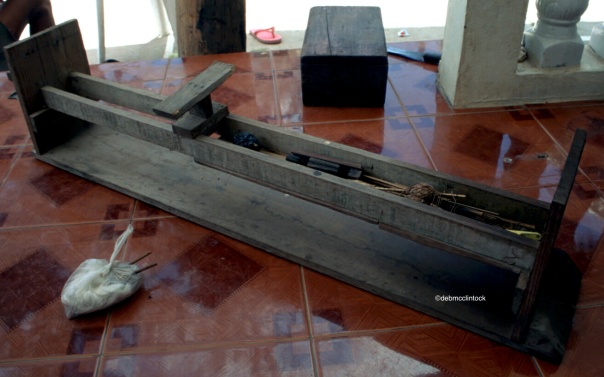
The hawng feum holds two bamboo sticks parallel to each other each, each split in half. There is a spacer tied into place between the two split bamboo sticks that ensures the space remains the same as the teeth are inserted and tied into place. A beater made of a metal strip and wood blocks is placed between the two bamboo stick halves. This is used to securely beat the teeth into place as the knots are tied.
A bamboo tooth is fit into place against the spacer in between the split bamboo sticks. A knot is tied at both the top and bottom or each end of the tooth. The knot alternates from different directions (inside and outside) with each tooth to stabilize the tooth and secure it to the split bamboo sticks that make up the top and bottom of the feum bamboo teeth assembly.
The outside 4 teeth are a little larger than the regular teeth in order to give support to the warp and strengthen the feum. These larger teeth stabilize the feum and help it hold up to pressure created by the cloth fell line as it is woven. Once the knots are tied, the bamboo tooth is beat into place with the temporary beater.
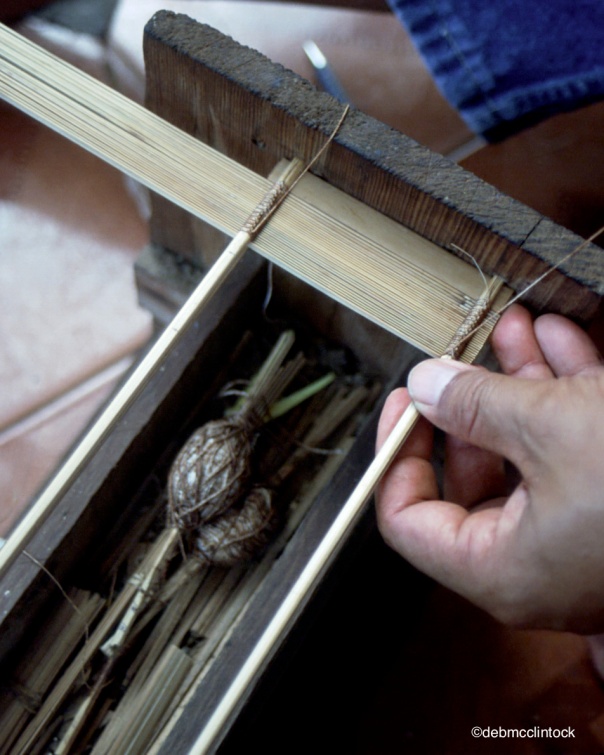 The feum maker ties about 3cm of the feum before testing how appropriate the size and spacing of the teeth are for the order specified. If they have to be trimmed down, he takes the work done apart and retrims the teeth on the khaing.
The feum maker ties about 3cm of the feum before testing how appropriate the size and spacing of the teeth are for the order specified. If they have to be trimmed down, he takes the work done apart and retrims the teeth on the khaing.
Once the correct teeth thickness is calibrated for the loupe ordered by the customer the feum maker continues beating the teeth in. Since he does a manual calibration for the reed size, the khiang set up is not moved until all the teeth are in place. As he uses up the bamboo teeth he has prepared, he scores the inserted teeth above the bamboo stick and begins to break them off, to create additional lengths to insert in the feum.
This process continues until the all feum teeth are in place. Glue is then applied to the knots to hold the twine in place under stress. We will refer to this finished assembly as the bamboo teeth reed.
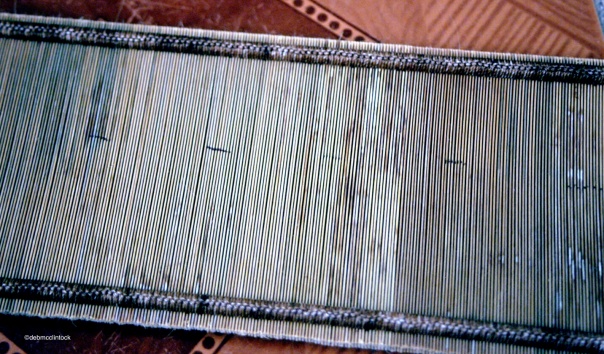 Once the feum’s bamboo teeth reed is tied and secured Kham Phoune prepares the top and bottom frame. Using a hammer and screwdriver as a chisel he prepares a hole for the left and right hand supports that hold the reed in place in both the top and the bottom of the frame.
Once the feum’s bamboo teeth reed is tied and secured Kham Phoune prepares the top and bottom frame. Using a hammer and screwdriver as a chisel he prepares a hole for the left and right hand supports that hold the reed in place in both the top and the bottom of the frame.
Once the frame is prepared he carefully taps the reed knots to flatten them so that they will fit securely in the slot in the feum reed frame. Usually some adjustment is needed before the reed fits into place easily. The reed is not glued into place in the frame in case some of the bamboo teeth break and need to be replaced. An outside right and left casing is prepared and held into place by pegs in the top and bottom of each side. A third set of holes is drilled which allows for the feum to be hung from the loom.
Once the bamboo teeth reed is securely fitted into the frame the bamboo teeth are shaved at an angle to smooth the teeth surface on both sides. Two grades of sandpaper are used to smooth the teeth. This final smoothing is only done to the side that faces the fell line of the cloth.
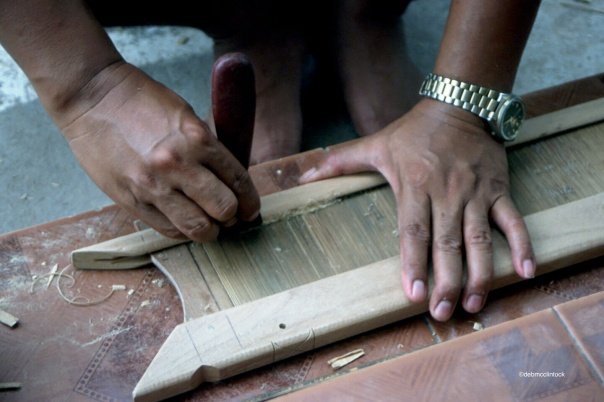 After the teeth are sanded smoothed, the feum is coated with diesel to protect it from insects. Typically the loupe and length of the feum are written on the front of the feum. The feum is now ready to be joined to the khao noy and the khao nyai.
After the teeth are sanded smoothed, the feum is coated with diesel to protect it from insects. Typically the loupe and length of the feum are written on the front of the feum. The feum is now ready to be joined to the khao noy and the khao nyai.
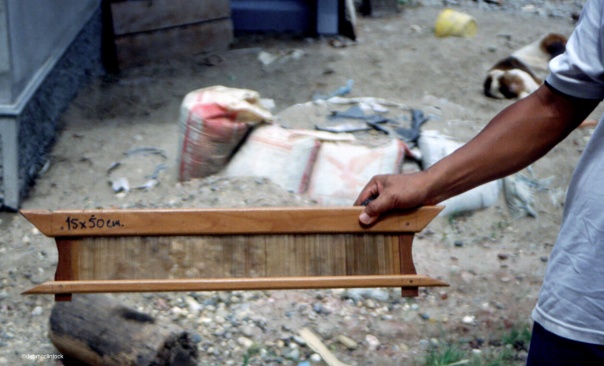
The Khao Noi (shafts) Are Made
Kham Phoune Sihamayavong’s wife, Latee, her daughter, Nat Ludee, niece and nephew worked steadily on the khao noi and the khao nyai as Kham Phoune worked on the feum. A master stand jig, called a hawng khao, constructed of pipes and wood side braces, provides physical support for preparing the khao noi string structure.
First, the cotton dummy warp is wound on in a figure 8 pattern. As the rounds are wound they are marked on with a permanent marker every 40 wrap rounds. This mark provides the guide for all other tying calculations. Recall that there are 40 teeth per 3.3 centimeters in the feum. The dummy warp wound in the shape of a figure 8 and marked accordingly provides the basic lease cross used for the clasped heddle construction. In Lao the word for the phrase, clasped heddle, is dill or diu. For instructive purposes the term, clasped heddle, will be used.
The diagram below illustrates the relationship of the creation of the clasped heddles to the figure 8 dummy warp and the order in which the khao noi and khao nyai clasped heddles are created.
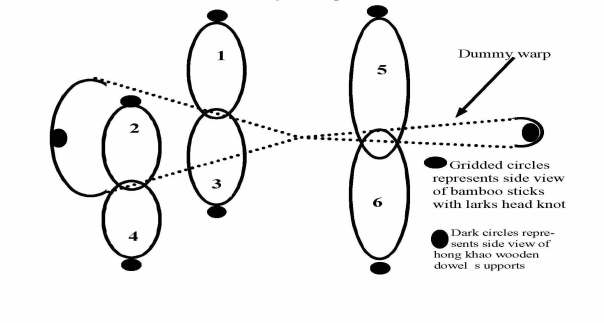 Figure 2
Figure 2
After the ground dummy warp is wound on the jig, the construction of the clasped heddles of the khao noi (shaft) begins. A stick is sanded and powdered to allow for sliding of the plastic string as the tension is put in and the knots put into place. The master knotting string feed is placed through the top of the figure 8 to begin the knotting of section 1 and 2 of the clasped heddles of the khao noi. This master knotting string feeds a continuous loop through the figure 8 dummy warp.
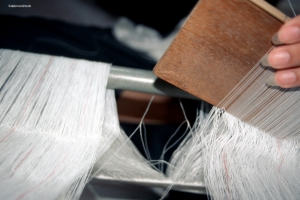
For the non-weaver a single warp thread is controlled by a single clasped heddle. The khao noi is made up of a number of clasped heddles. The nylon string used to construct the clasped heddles comes in various sizes depending on the strength and density needed for the desired warp. In this case a size 6 was used for the khao noi and a size 9 used for the khao nyai.
A small wooden jig, called a pong, is cut to the desired length, half of the clasped heddle. It is secured to the starting end of the master knotting string and is placed against the khao noi stick. Using a lark’s head knot the heddle maker wraps the master knotting string around the jig, captures every other one of the dummy warp threads, creates a second knot to complete the loop and continues on to the next half heddle. Picking up only one half of the figure 8 the entire bottom row of the first shaft is constructed.
The important key item is that alternating dummy threads are captured in the clasped loop as the larks head is knotted around the shaft stick. A second bamboo stick is prepared and again the clasped heddles are constructed around the opposite alternating threads in the figure 8. At this point each shaft has the bottom half of its heddles constructed with the dummy warp already threaded through the heddle. See 1 and 2 in figure 2. In other words, there are heddles attached to the bottom of the figure 8 round.
Once both halves of the khao noi are completed on one side, the stick assembly is flipped over on the hawng khao, and the bottom half of both the khao noi are knotted and secured to a dummy warp. The same knotting process takes place except in this second set of clasped heddles the first clasped heddle is picked up and clasped to the second heddle as it is knotted. See 3 and 4 in figure 2. In other words, the bottom half of both shafts are constructed first and then the top half is constructed and joined to the first set. Set 1 is joined to set 3 and set 2 to set 4. Hence, when the process is complete a complete shaft of clasped heddles is constructed that each hold one dummy warp in each clasped heddle. This is achieved by the use of the figure 8 dummy warp configuration and following closely each dummy thread loop as the clasped heddles are constructed.
The Khao Nyai is Made
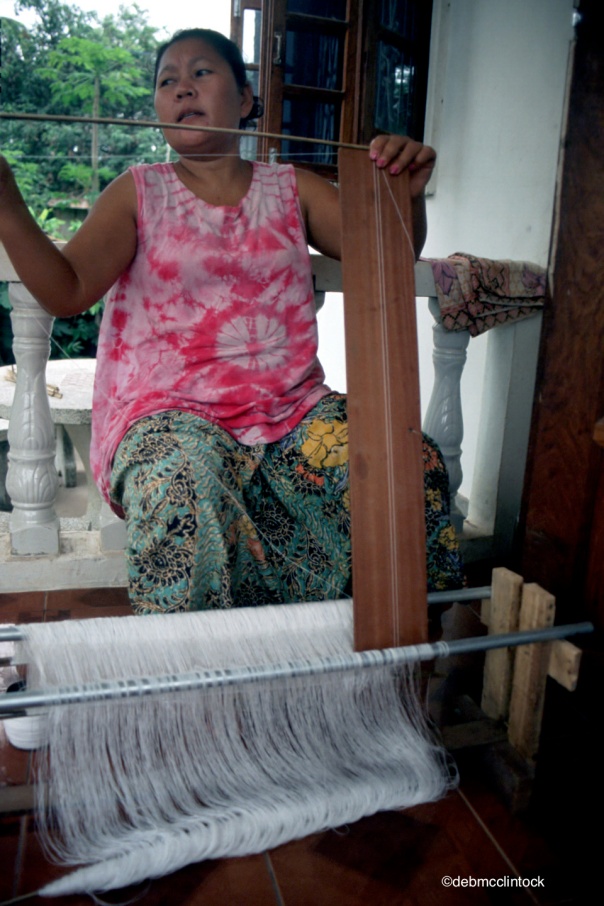 A large wooden jig or pong is brought in to construct the khao nyai. Once again, the jig is cut to the appropriate size as requested by the weaver. The same process is followed as the khao noi for creating the lower half of the clasped loop heddles. See 5 in figure 2. As the loop is created the guide threads are picked up and secured within the khao nyai loop. However, in the khao nya both threads are picked up in the clasped heddle. Hence each clasped heddle stores two of the dummy warps threads that allows the storage of pick up patterns when weaving. Once the top portion of the khao nyai is constructed the stick assembly is flipped over and the bottom portion of the khao nyai is constructed using the same knotting method. See 6 in figure 2.
A large wooden jig or pong is brought in to construct the khao nyai. Once again, the jig is cut to the appropriate size as requested by the weaver. The same process is followed as the khao noi for creating the lower half of the clasped loop heddles. See 5 in figure 2. As the loop is created the guide threads are picked up and secured within the khao nyai loop. However, in the khao nya both threads are picked up in the clasped heddle. Hence each clasped heddle stores two of the dummy warps threads that allows the storage of pick up patterns when weaving. Once the top portion of the khao nyai is constructed the stick assembly is flipped over and the bottom portion of the khao nyai is constructed using the same knotting method. See 6 in figure 2.
It should be stressed the critical part of this entire process is the master knotting thread which feeds through the figure 8 portion and facilitates keeping all the clasped heddles connected through the use of this nylon thread in the knotting process. The use of the dummy warp allows the weaver to avoid threading the loom in that the weaver can tie onto the dummy warp to pull the actual warp threads through the khao nyai, the khao noy, and the feum.
Once the khao nyai is complete, the khao nyai and khao noi are rolled up and secured with rubber bands. The entire structure is then carefully placed next to the feum and the top portion of the figure 8 guide string near the khae nois is fed through the feum bamboo teeth. These dummy warps are then tied to secure and the feum is flipped over and the other side of the dummy warps are tied against the khao nyai. The pipe jig that held this figure 8 in place is eased out of the structure as the dummy warp is secured.
Once the dummy warps are secured to the feum, the khao noi and the khao nyai are carefully wrapped to avoid tangling and the khao tam huuk is delivered to the customer, ready to create a wonderfully intricate textile in the Lao tradition.
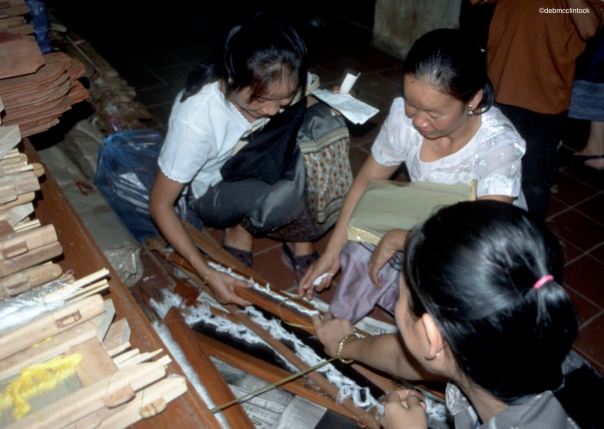
Written and photographed by Deb McClintock – June 2002
This paper not to be reproduced without prior written consent by Deb McClintock
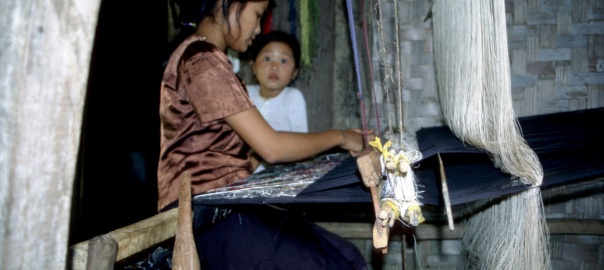








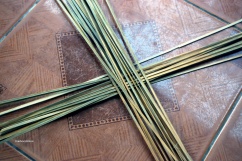








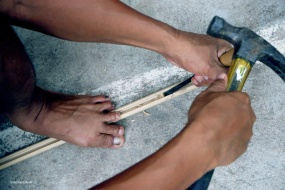



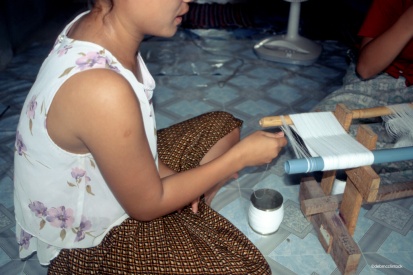







I cant’t wait until later to slowly read this wonderful blog. The pictures are inviting me to spend time reading!
This is a great report Deb. I’m pleased that you republished it. Kay
Thank you, finally have time to focus on updating blog. More to come!
I saw this type of loom and weaving when we were in that area several years ago. Amazing, the intricate weaving they do on such primitive equipment.